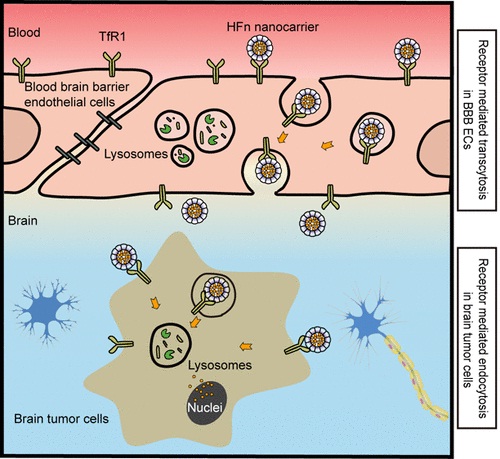Release date: 2018-04-13

This is the discovery of ferritin tumor targeting by Yan Xiyun's group and applied it to in vitro diagnosis of tumors (Nature Nanotechnology, 2012), in vivo therapy (PNAS, 2014) and in vivo tumor multimodal imaging (ACS Nano, 2016). Another important result after that.
The blood-brain barrier is a natural barrier to maintain central nervous system homeostasis and protect brain tissue from metabolic damage. However, while protecting the nervous system, the blood-brain barrier also makes almost 100% of macromolecular drugs and 98% of small molecule drugs unable to reach brain tissue effectively, resulting in most central nervous system diseases such as malignant brain tumors not being effective. Treatment. Therefore, for brain diseases such as malignant brain tumors, the biggest challenge facing clinical treatment at present is how to effectively pass probes or drugs across the blood-brain barrier.
Receptor-mediated transcytosis is currently the most effective way to mediate biomacromolecular drugs across the blood-brain barrier. Among them, transferrin receptor 1 (TfR1) is the most representative transcytosis receptor. Since TfR1 is simultaneously highly expressed on brain endothelial cells and malignant brain tumor cells, the drug targeting TfR1 can theoretically cross the blood-brain barrier and be enriched in the brain malignant brain tumor site. However, since most of the antibodies or ligands that target TfR1 are too high in affinity with TfR1, they are degraded in the lysosomes enriched in brain endothelial cells during the process of crossing the blood-brain barrier, resulting in their inability to cross the blood brain. The barrier reaches the lesion.

Progress in the study of ferritin crossing the blood-brain barrier and targeted therapy for malignant brain tumors
In the search for the ideal TfR1 ligand, the researchers first discovered that ferritin binds to the receptor TfR1 and crosses the blood-brain barrier through transcytosis of brain endothelial cells without being blocked in lysozyme. In malignant brain tumor cells, under the mediation of the receptor TfR1, ferritin is specifically enriched in lysosomes to degrade, thereby releasing its internally loaded drugs. This property of ferritin makes it an ideal drug carrier that can cross the blood-brain barrier and be used in the treatment of malignant brain tumors. In normal mice, the researchers confirmed that ferritin can effectively cross the intact blood-brain barrier; in a mouse model of orthotopic transplantation of malignant brain tumors, ferritin can specifically enrich tumors after crossing the blood-brain barrier. The region also inhibits the growth of malignant brain tumors, while there is no significant enrichment in normal brain tissue. In addition, animal safety experiments and pathological analysis showed that ferritin can specifically kill malignant brain tumors without damage to normal brain tissue. Studies have shown that the proper binding affinity of ferritin to TfR1, the symmetrical structure of multiple binding sites, and the ideal nano-size effect are reasons for its ability to cross the blood-brain barrier and have excellent selectivity for tumor tissues.
Combined with the characteristics of ferritin newly discovered in this study, its easy preparation, good biocompatibility and high drug loading, ferritin can be used as an ideal nano-drug carrier for targeted therapy of malignant brain tumors. At the same time, ferritin also provides a potential nano drug carrier platform for other types of central nervous system diseases such as neurodegenerative diseases.
Fan Xilong, associate researcher of Yan Xiyun, Ph.D., Zhou Meng, and Dr. Jia Xiaohua, Tian Jie, are the co-first authors of the paper. The research was funded by the National Natural Science Foundation of China, the Chinese Academy of Sciences Pilot Project, the National Science and Technology Major Project, and the Young Talents Support Project.
Source: Biophysical Institute Sharing:
These test kits are new to the market and rely on the detection of viral proteins in swab samples They consist of monoclonal antibodies specific for the viral antigens and results are seen by the naked eye by way of chromatographic particles. There have only been a few of these tests commercialized and normally require a high viral count to work effectively. In the first few months of the pandemic some national health authorities questioned the reliability of these tests, as they usually require a higher viral count that qPCR to show positive. Therefore, false-negatives can occur.
antigen test kit, rapid antigen test kit, covid-19 antigen test, antigen detection, antigen rapid test kit
Shenzhen Uni-medica Technology Co.,Ltd , https://www.unimed-global.com